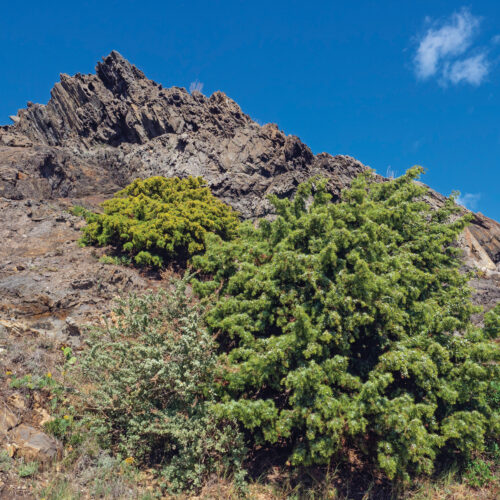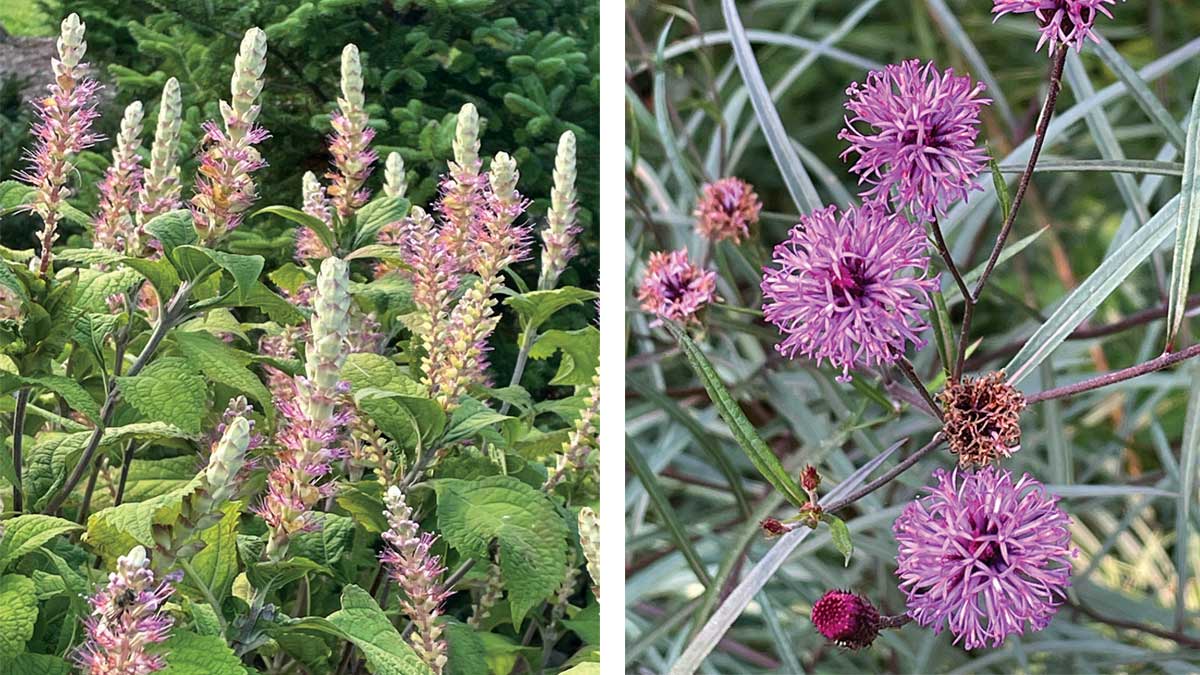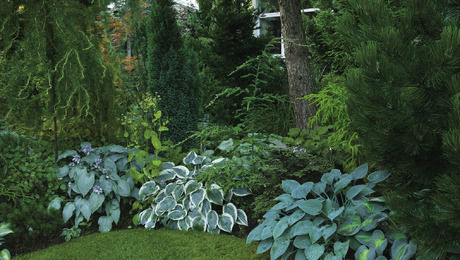
Few plants generate more revulsion in the garden than junipers. The mere suggestion of planting one often musters a similar reaction to that of saying a dirty word. Maybe we’ve grown weary of their use as evergreen blobs in foundation plantings. Perhaps the thought of meticulously shearing them into the perfect shape sounds daunting (see pruning tips). It could be an early memory of an itchy rash from an up-close encounter with a juniper’s prickly branches. Or it could be boredom with the sea of creeping blue rug junipers (Juniperus horizontalis ‘Wiltonii’, Zones 3–9) planted in every big-box-store parking lot. Although junipers are a midcentury-modern garden staple, generations of gardeners have since decided they have had enough of these controversial conifers. While it’s easy to dismiss them for their deeply ingrained negative traits, junipers have many merits that make them worth reconsideration.
They’re durable and an invaluable resource for wildlife
In an ever-changing world with an unpredictable future, people now more than ever are concerned with the role plants play in the ecology of their gardens. With over a dozen species native to North America, junipers can be a natural, superhero plant pick. Many charismatic backyard birds love and even depend on junipers. Their berries (fleshy cones) are a favorite for warblers, cardinals, eastern bluebirds, and many others. Not only are the berries tasty, but they are also important winter food sources when most other plants are dormant. These evergreens provide shelter from bitter cold and strong winds, while the bristly foliage is a perfect place for a fortified nest. If you are looking to increase bird activity and habitat in the garden, junipers are a top choice. See Berry-Producing Plants for the Birds
Junipers are hosts to dozens of insect species, including various caterpillars, true bugs, and beetles. Such insects form the base of the garden food chain, attracting beneficial predatory insects as well as supporting insectivorous birds, frogs, and small mammals. While these insects do consume the juniper’s foliage and sap, few of them cause any real aesthetic damage or inflict harm on the plant.
| JUNIPER FACTS |
What makes junipers so special?
Many of the detractors of junipers lose sight of their many good and ecologically important qualities. Yes, they are prickly and require gloves to handle in some cases. But this adaptation is for good reasons. Wet springs, drought, and harsh winters that threaten other woody plants don’t bother junipers. They are hardy plants that make it through most climate conditions with only a little help. Below are some of the traits that make junipers as a group so incredible.
Benefits of growing junipers
- Like many garden plants, they appreciate a little water during dry periods just to keep them from stressing out. However, extensive root systems make them more resistant to drought.
- Strong wind doesn’t generally cause damage to junipers.
- They are naturally deer resistant due to their prickly demeanor.
- Because they are native to much of the continent, there are varieties that can handle hot, humid summers, and ones that tolerate cold, dry winters.
- Junipers also have very few disease problems compared to other conifers that are plagued by fungal infections.
With all of these marvelous benefits, it’s hard to believe that junipers are still the black sheep of the conifer world. With extensive selection efforts over the years, these plants are now available in many shapes, sizes, and colors. Not all junipers are blue rug; there’s a world beyond that ubiquitous cultivar waiting to be discovered.
Creeping and Shrubby Juniper Forms
Creeping or shrubby habits offer great placement versatility
|
|
‘Grey Owl’ eastern red cedarName: Juniperus virginiana ‘Grey Owl’ Zones: 4–9 Size: 2 to 3 feet tall and 5 to 6 feet wide Conditions: Full sun; tolerant of a wide range of well-drained soil types Native range: Hybrid |
Junipers are well known for their erosion-control properties. Varieties that hug the ground are invaluable in keeping slopes stable and slowing down potential runoff. But shrubby junipers can also be utilized as low hedges or placed to soften the edges of stone walls. Chances are there’s a beautiful option that will fit any practical or aesthetic need you may have.
The silvery-gray foliage on the arching branches of ‘Grey Owl’ eastern red cedar (seen above) gives it a charming growth habit. Great as a tall ground cover or short hedge, specimen plant, or planted in groups, this soft-textured evergreen adds pewter tones and coolness to the garden. Other qualities include drought resistance, minimal pruning needs, and few pest or disease problems.
|
|
‘Limeglow’ creeping juniper adds contrast to dark backdropsname: J. horizontalis ‘Limeglow’ Zones: 3–9 Size: 2 feet tall and 4 feet wide Conditions: Full sun; tolerant of a wide range of well-drained soil types Native range: Alaska, Canada, northern United States |
‘Limeglow’ creeping juniper is an apt name for this electric-hued conifer. Feathery foliage and a spreading habit make it a great native selection for a sunny border, in front of a deep green hedge, or against a dark wall or fence. With no serious pest or disease issues, this plant is drought tolerant once established and is resistant to scorch in hot sun.
|
|
The golden color of ‘Sunsplash’ shore juniper won’t burn outname: J. conferta ‘Sunsplash’ Zones: 5–9 Size: 15 inches tall and 5 or more feet wide Conditions: Full sun; well-drained soil Native range: Japan, Sakhalin Island |
A brightly variegated form of shore juniper from the Far East, ‘Sunsplash’ sports golden patches of foliage among dark green branches. This creeping juniper is not matting; rather, it forms many long, spreading branches that hug the ground. This habit makes it a great candidate for rock gardens, wall plantings, and containers. The gold does not fade or burn as it does with many other yellow-hued conifers. If you want a low-maintenance plant, this is a perfect choice.
|
|
‘Pancake’ creeping juniper carpets the ground with tufts of powder bluename: J. horizontalis ‘Pancake’ Zones: 3–9 Size: 2 to 4 inches tall and 3 to 4 feet wide Conditions: Full sun; well-drained soil Native range: Alaska, Canada, northern United States |
‘Pancake’ is not your average blue creeping juniper. Tightly hugging the ground, this native plant often reaches no taller than 2 inches, forming a carpet of powdery blue foliage. ‘Pancake’ is great for rock gardens, along pathways, or in wall plantings where it can tolerate dry conditions and high heat while elegantly draping over hardscape.
|
|
‘Andorra Compact’ juniper has
|
Rich purple winter color contrasts with bright blue tips to make ‘Andorra Compacta’ a superior nativar and a must-have ground-cover juniper. Slowly spreading over time, this conifer looks its best when gracefully cascading over a wall or container. It’s a great choice for erosion control or in a sunny spot where it can be seen from a window in winter. This is a highly drought-tolerant variety and is also extremely disease and pest resistant.
Upright Juniper Forms
Upright forms serve as valuable focal points and screening
|
|
‘Skyrocket’ Rocky Mountain juniper thrives in all kinds of soilName: J. scopulorum ‘Skyrocket’ Zones: 4–9 Size: 15 to 20 feet tall and 3 feet wide Conditions: Full sun; well-drained soil Native range: Rocky Mountains |
Whether pyramidal in shape or sporting a distinctive weeping habit, junipers that grow more tall than wide add invaluable character to the landscape. Their silhouette often determines the best placement.
Named for its tight and upright form, ‘Skyrocket’ Rocky Mountain juniper is a fast-growing plant sporting silvery blue-green foliage year-round. This native tree requires very little care in the form of pruning or watering after establishment. ‘Skyrocket’ has few if any disease or pest problems and is surprisingly drought tolerant. Plant it wherever you want height, or use it as a screening option that won’t take up much ground area. One word of warning: While this variety tolerates a range of soil types, it resents wet feet.
|
|
‘Canaertii’ eastern red cedar may be the most drought-tolerant optionname: J. virginiana ‘Canaertii’ Zones: 3–9 Size: 20 to 30 feet tall and 10 to 15 feet wide Conditions: Full sun; adaptable to most well-drained soil types Native range: Eastern United States |
A fast-growing juniper that displays distinct character over time, ‘Canaertii’ eastern red cedar is a perfect focal-point plant or screen, or it can be aligned on an axis with your home for scale. It has an overall pyramidal habit, with open and angular branches. Its cobalt blue berries are a bird favorite, and it has no serious pest or disease issues. Extremely drought tolerant, ‘Canaertii’ is a unique native selection that is sure to add interest to almost any garden.
|
|
Weeping temple juniper is a piece of living art in the landscapename: J. rigida ‘Pendula’ Zones: 5–8 Size: 20 to 30 feet tall and 10 to 12 feet wide Conditions: Full sun; moist, well-drained soil Native range: Northern China, Mongolia, Korea, Japan, southeastern Russia |
Growing into an architectural medium-size tree, weeping temple juniper has a strong central leader with elegantly upward arching branches that are covered with delicate evergreen foliage. An exceptional specimen plant or unique collector’s tree, it is drought tolerant and has no serious disease problems. As a bonus, the needles turn bronze in winter only to return to a lush green in summer.
|
|
‘Blue Arrow’ Rocky Mountain juniper is a space-conscious beautyname: J. scopulorum ‘Blue Arrow’ Zones: 4–9 Size: 12 to 15 feet tall and 2 feet wide Conditions: Full sun; well-drained soil Native range: Rocky Mountains |
Aqua-blue foliage beautifully complements the powdery silvery-blue berries of ‘Blue Arrow’ Rocky Mountain
juniper. Those berries are much loved by birds and other wildlife. Requiring minimal care, this upright, extremely narrow native tree should be watered well when young, but it becomes drought tolerant at maturity. I think it looks stunning when used as a space-saving hedge, but it is equally eye-catching as a specimen plant.
|
|
‘Gold Cone’ common juniper prefers cooler climesname: J. communis ‘Gold Cone’ Zones: 2–7 Size: 3 to 5 feet tall and 1 to 2 feet wide Conditions: Full sun; light, well-drained soil Native range: Northern North America |
The new growth that emerges in spring from ‘Gold Cone’ common juniper is an unbelievably bright yellow that ages to shades of blue-green in summer. If you’re looking for a smaller, native selection of juniper, this is the perfect choice. Ideal for foundation plantings, rock gardens, or in containers, this evergreen is drought tolerant once established and, like most junipers, has few pest or disease issues. Pruning is largely unnecessary with this petite variety. Preferring cooler climates, ‘Gold Cone’ is best grown in Zone 7 or lower. Avoid heavy or wet soil if you want it to have a long life.
| TECHNIQUE |
Pruning dos and don’ts
Like many conifers, junipers very rarely need to be pruned. You may, however, opt to trim them for looks or to make space where they may have overgrown their boundary. Although by no means a thorough tutorial on how to prune a juniper, the following are a few basics to keep in mind before grabbing the pruners.
1. The best time to prune junipers is just before a flush of new growth in late spring or early summer.
2. Unlike some conifers, these evergreen trees will not form new buds on old wood. So if you cut back to the brown, aged stems, the tree won’t grow back.
3. By making some discerning cuts, you can clean out crowded areas and give breathing room to the surrounding plants.
4. Prune back any dead wood. Follow dead branches back to their origination point, then cut and remove them.
5. Use heading cuts (trimming back to a branch’s “head,” or terminal growth; or back to a bud, a stub, or a smaller branch) to enhance the tree’s shape. This trimming often produces new growth below the cut.

David McKinney is the curator of collections and grounds at the Iowa Arboretum and Gardens, where he manages 40 acres of arboretum and 120 acres of native woodland/prairie.
Sources
The following mail-order retailers offer many of the plants featured in this article:
• Conifer Kingdom, Silverton, OR; 503-874-4123; coniferkingdom.com
• Nature Hills Nursery, Omaha, NE; 402-934-8116; naturehills.com
• Plant Delights Nursery, Raleigh, NC; 919-772-4794; plantdelights.com
• Singing Tree Gardens and Nursery, McKinleyville, CA; 707-839-8777; singtree.com
































Comments
Log in or create an account to post a comment.
Sign up Log in